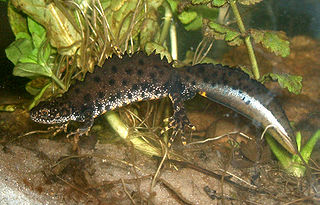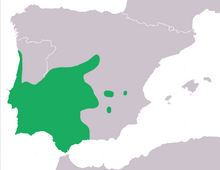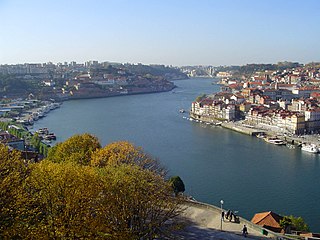
The northern crested newt, also known as the great crested newt or warty newt is a newt in the family Salamandridae, found across Europe and parts of Asia.

Triturus is a genus of newts comprising the crested and the marbled newts, which are found from Great Britain through most of continental Europe to westernmost Siberia, Anatolia, and the Caspian Sea region. Their English names refer to their appearance: marbled newts have a green–black colour pattern, while the males of crested newts, which are dark brown with a yellow or orange underside, develop a conspicuous jagged seam on their back and tail during their breeding phase.

The southern crested newt is a terrestrial European newt. It is similar to the northern crested newt except larger and more robust.

The striped newt, Notophthalmus perstriatus, is a species of aquatic salamander native to the southeastern United States. It is a close relative of the eastern newt, with which it shares territory, and can be distinguished from the latter by the presence of red stripes running down the sides of its back and red spots on its back that lack a black outline.

The Algerian ribbed newt is a species of salamander in the family Salamandridae found in Algeria and Tunisia. The natural habitats of this newt are rivers, intermittent rivers, swamps, cisterns, freshwater marshes, intermittent freshwater marshes, and ponds. It is threatened by habitat destruction.

Pleurodeles poireti, the Edough ribbed newt or Poiret's newt, is a species of salamander in the family Salamandridae. It is found only in the Edough Massif, in the north east of Algeria.

Boscá's newt, also known as the Iberian newt, is a species of newt in the family Salamandridae. The species is found in Portugal and western Spain.

The Danube crested newt or Danube newt is a species of newt found in central and eastern Europe, along the basin of the Danube river and some of its tributaries and in the Dnieper delta. It has a smaller and more slender body than the other crested newts in genus Triturus but like these, males develop a conspicuous jagged seam on back and tail during breeding season.

The Italian newt is a species of salamander in the family Salamandridae found only in Italy. Its natural habitats are temperate forests, temperate shrubland, Mediterranean-type shrubby vegetation, freshwater lakes, intermittent freshwater lakes, freshwater marshes, intermittent freshwater marshes, arable land, pastureland, rural gardens, water storage areas, ponds, and canals and ditches. It is threatened by habitat loss. It was formerly known as Triturus italicus, but was relocated to the genus Lissotriton after Triturus was split.

The Carpathian newt, or Montadon's newt, is a species of salamander in the family Salamandridae found in Czech Republic, Poland, Romania, Slovakia, and Ukraine.

The southern banded newt is a species of salamander in the family Salamandridae found in Iraq, Israel, Jordan, Lebanon, Syria, and Turkey.

The African common toad or guttural toad is a species of toad in the family Bufonidae. It is found in Angola, Botswana, Democratic Republic of the Congo, Kenya, Lesotho, Malawi, Mauritius, Mozambique, Namibia, Réunion, Somalia, South Africa, Ethiopia, Swaziland, Tanzania, Zambia, and Zimbabwe. Its natural habitats are subtropical or tropical dry forest, subtropical or tropical moist lowland forest, subtropical or tropical moist montane forest, dry savanna, moist savanna, temperate shrubland, subtropical or tropical dry shrubland, subtropical or tropical moist shrubland, subtropical or tropical dry lowland grassland, subtropical or tropical seasonally wet or flooded lowland grassland, subtropical or tropical high-altitude grassland, intermittent rivers, freshwater lakes, intermittent freshwater lakes, freshwater marshes, intermittent freshwater marshes, arable land, pastureland, rural gardens, urban areas, heavily degraded former forest, ponds, and canals and ditches.

The Betic midwife toad or Sapo Partero Bético is a species of frog in the family Alytidae. It is endemic to mountainous in south eastern Spain. Its natural habitats are temperate forests, freshwater marshes, intermittent freshwater marshes, pastureland, ponds, and aquaculture ponds. It is threatened by habitat loss.

The marbled snout-burrower is a species of frog in the family Hemisotidae. It is found in Angola, Benin, Botswana, Burkina Faso, Cameroon, Central African Republic, Chad, Democratic Republic of the Congo, Ivory Coast, Eritrea, Ethiopia, Gambia, Ghana, Guinea, Guinea-Bissau, Kenya, Malawi, Mozambique, Namibia, Nigeria, Senegal, Somalia, South Africa, Sudan, Swaziland, Tanzania, Uganda, Zambia, Zimbabwe, possibly Burundi, possibly Mali, possibly Niger, possibly Rwanda, possibly Sierra Leone, and possibly Togo. Its natural habitats are subtropical or tropical dry forest, subtropical or tropical moist lowland forest, dry savanna, moist savanna, subtropical or tropical moist shrubland, subtropical or tropical high-altitude grassland, swamps, freshwater lakes, intermittent freshwater lakes, freshwater marshes, intermittent freshwater marshes, arable land, plantations, seasonally flooded agricultural land, and canals and ditches. It is also called the mottled shovelnose frog and marbled shovelnose frog.

The Iberian parsley frog is a species of frogs in the family Pelodytidae, known as "parsley frogs" because of their green speckles. This species is only found in Portugal and Spain; in Spanish it is known as sapillo moteado ibérico.

A newt is a salamander in the subfamily Pleurodelinae. The terrestrial juvenile phase is called an eft. Unlike other members of the family Salamandridae, newts are semiaquatic, alternating between aquatic and terrestrial habitats. Not all aquatic salamanders are considered newts, however. More than 100 known species of newts are found in North America, Europe, North Africa and Asia. Newts metamorphose through three distinct developmental life stages: aquatic larva, terrestrial juvenile (eft), and adult. Adult newts have lizard-like bodies and return to the water every year to breed, otherwise living in humid, cover-rich land habitats.
Ommatotriton ophryticus, the northern banded newt, is a species of newt in the family Salamandridae. It is found in northeastern Turkey and western Caucasus in Georgia, Armenia, and southern Russia.

The Anatolian crested newt is a newt species endemic to northern Anatolia in Turkey. Before its description in 2016, it was first considered to belong to the southern crested newt and then the Balkan crested newt. The three species form a complex of morphologically indistinguishable cryptic species. Genetic data demonstrated the Anatolian crested newt to be distinct from the other two species, although it hybridises with the Balkan crested newt at its western range end.





























